Curated by Jenchieh Hung, Principal Curator, and Nada Inthaphunt, Executive Curator, Collective Language—Asian Contemporary Architecture Exhibition delves into the diversity and distinctions that language brings to hearing, vision, touch, and smell. It is structured into three chapters: “Sound / Language of Humanity,” “Silent / Language of Shading,” and “Perceive / Language of Ritual.”

ภาษาเป็นตัวจุดประกายความคิดสร้างสรรค์
ภาษาที่ว่านี้ไม่เพียงหมายรวมเพียงความหมายของ ‘ภาษา’ ที่แปลว่า คำพูดเพื่อการสื่อสารในทางตรงเท่านั้น แต่ยังหมายถึงภาษาในฐานะเครื่องมือของการสื่อสาร อย่างภาษาท่าทาง หรือภาษาแสดงอารมณ์ความรู้สึกและความต้องการ ภาษาผ่านสัญชาตญาณเหล่านี้พัฒนาวิวัฒนาการของมนุษย์จนเกิดเป็นภาษาคำพูด และพัฒนาต่อเป็นภาษาทางวัตถุ อย่างผลงานศิลปะ หรือสถาปัตยกรรม ซึ่งบอกกับเราผ่านทางผลงานว่าเราสามารถเข้าใจกันและกันได้
‘COLLECTIVE LANGUAGE : สัมผัส สถาปัตย์’ เป็นแนวคิดหลักของงานสถาปนิก’67 เพื่อพาผู้ชมไปสัมผัสประสบการณ์ของงานออกแบบที่ไร้ขอบเขตทั้งด้านภาษาคำพูดหรือเขตแดนประเทศ เชื่อมโยงผู้คนจากแวดวงสถาปัตยกรรมทั่วโลกเข้ามาไว้ร่วมกันภายในงาน ผ่านการถ่ายทอดผลงานทางสถาปัตยกรรม ที่เป็นมากกว่าอรรถาธิบาย แต่เป็นความรับรู้และเข้าใจร่วมกัน
แนวความคิดทั้งหมดถ่ายทอดผ่านนิทรรศการหลักและกิจกรรม ต่าง ๆ ภายในงาน ที่ต้องการเน้นการ ‘สัมผัส’ ในแบบ ‘สถาปัตย์’ ในการสื่อสาร โดยหวังให้สร้างแรงบันดาลใจและก่อให้เกิดการเคลื่อนไหวที่ดีในอนาคตร่วมกันของผู้คนในวงการ ถอดรหัสภาษา : นิทรรศการสัมผัสสถาปัตย์ ภาษาร่วมสมัยภูมิภาคเอเชีย (Collective Language – Asian Contemporary Architecture) มาจากแนวคิดเรื่องภาษาเป็นสื่อกลางหนึ่งในการเชื่อมโยงทุกสิ่งในโลกนี้เข้าด้วยกัน นับตั้งแต่หลายหมื่นหรือแม้กระทั่งหลายล้านปีก่อน การใช้ภาษาปรากฏอยู่ในรูปแบบต่าง ๆ ในสิ่งมีชีวิตหลากหลายชนิด ไม่ว่าจะเป็นภาษาเสียงที่เป็นเสียงหวีดร้อง (Whistle Language) ภาษากาย ภาษาการสัมผัส ภาษากลิ่น และอื่น ๆ อีกมาก อย่างไรก็ตาม ที่มาและวิวัฒนาการของภาษายังคงเป็นประเด็นที่ได้รับการถกเถียงกันมาตลอด ในปี 1809 นักชีววิทยาชาวฝรั่งเศส ฌอง-แบพติสท์ ลามาร์ก (Jean-Baptiste Lamarck) ได้เผยแพร่หนังสือ “ปรัชญาสัตววิทยา” (Zoological Philosophy) โดยเสนอแนวคิดว่าเมื่อสภาพแวดล้อมเปลี่ยนแปลงไปสิ่งมีชีวิต แต่ละสายพันธุ์ก็จะปรับตัวและพัฒนาอวัยวะของตัวเองขึ้นมา การปรับตัวนี้นำไปสู่การเจริญเติบโตของอวัยวะที่ใช้งานบ่อย ๆ และการเสื่อมสลายลงอย่างค่อยเป็นค่อยไปของอวัยวะที่ไม่ได้ใช้งาน ก่อนที่การเปลี่ยนแปลงในแต่ละรุ่นจะถูกส่งต่อไปยังรุ่นต่อ ๆ ไป การหารือในประเด็นนี้ ไม่เพียงแต่นำมุมมองใหม่ ๆ มาสู่นักภาษาศาสตร์เท่านั้น หากแต่ยังสะท้อนให้เห็นว่าสิ่งมีชีวิตชนิดต่าง ๆ ได้ใช้วิธีการที่หลากหลายในการสื่อสารผ่านภาษามาเป็นเวลานับล้านปี
เจอร์รี่ หง ประธานจัดงานนิทรรศการและภัณฑารักษ์หลักของสมาคมฯ เจาะลึกทั้งความหลากหลาย และความแตกต่างที่ภาษานำมาสู่การได้ยิน การมองเห็น การสัมผัส และการรับกลิ่น โดยแบ่งเป็น 3 หัวข้อ ได้แก่ “เสียง/ภาษาของมนุษยชาติ” “ความเงียบงัน/ภาษาของแสงเงา” และ “ซึมซาบ/ภาษาของพิธีกรรม” บริษัทสถาปนิกกว่า 50 แห่งจาก 15 ประเทศในเอเชียได้นำเสนอผลงานสถาปัตยกรรมร่วมสมัยของภูมิภาคผ่านเรื่องราวทั้งสามนี้
“ภาษาคือการสื่อสารออกมาให้ผู้รับสารเข้าใจในข้อมูลหรือความต้องการของเรา แต่ถ้าเกี่ยวกับนิทรรศการนี้แล้ว ภาษาคือการสื่อสารแบบสองทางไปกลับ ระหว่างตัวงานของสถาปนิกที่มาจากหลากหลายประเทศกับเราที่เป็นผู้ชม”
นาดา อินทพันธ์ ผู้รับหน้าที่เป็น Executive Curator ของนิทรรศการธีมงาน COLLECTIVE LANGUAGE : สัมผัสสถาปัตย์ ตีความการสัมผัสภาษามาสู่การสร้างสรรค์พื้นที่นิทรรศการหลักซึ่งเธอบอกว่า “เหมือนเป็นประตูสู่ความเข้าใจภาษาทางด้านสถาปัตยกรรม”
จากโจทย์ของภาษาสถาปนิ ก ร่วมกันกับการยกระดับนิทรรศการสู่ระดับนานาชาติ จึงนำมาสู่ความร่วมมือกับสมาคมพันธมิตร 21 ประเทศใน The Architects Regional Council Asia หรือ ARCASIA ในการเชื้อเชิญมาสัมผัสภาษาร่วมกันผ่านงานสถาปัตยกรรมจากต่างวัฒนธรรม ต่างที่มา ความคิด และต่างประเทศ
“เริ่มแรกจากคำว่า ‘Collective Language’ เราทำงานกับ กุลธิดา ทรงกิตติภักดี ประธานจัดงาน ร่วมกันถอดรหัสออกมาได้ว่า ภาษาร่วมกันในทางสถาปัตยกรรมแบ่งได้เป็น 3 หมวด ตามลำดับหรือเลเยอร์ของประสบการณ์ในการสัมผัสและปฏิสัมพันธ์เวลาเผชิญกับสถาปัตยกรรม เริ่มตั้งแต่แรกสุดที่ผิวเผินที่สุดคือเรื่องเสียง สู่ลำดับถัดมาเข้าสู่ความเงียบที่ลึกซึ้งขึ้น ก่อนไปสู่ลำดับสุดท้ายคือเริ่มเข้าถึงจิตวิญญาณ โดยใช้โปรเจกต์งานสถาปัตยกรรมเป็นการยกตัวอย่างให้เห็นภาพชัดเจนยิ่งขึ้น”

นิทรรศการที่เกิดขึ้นจากคำถามในใจกับภาษาสถาปัตยกรรมแบบ ‘เอเชีย’ ของ เจอร์รี่ หง ประธานคณะทำงานนิทรรศการจากสมาคมสถาปนิกสยามฯ ในงานสถาปนิก’67
บทเรียนสถาปัตยกรรมมักนิยามถึงสถาปัตยกรรมไทย สถาปัตยกรรมจีน สถาปัตยกรรมญี่ปุ่น หรือสถาปัตยกรรมภายใต้ชื่อที่เป็นอัตลักษณ์ของแต่ละประเทศ แต่พอมาคิดทบทวนดูแล้ว เราเคยได้ยินคำว่า ‘สถาปัตยกรรมเอเชีย’ กันไหม?
เจอร์รี่ หง (Jenchieh Hung) ผู้ร่วมก่อตั้งและสถาปนิกหลัก จาก HAS design and research และประธานคณะทำงานนิทรรศการจากสมาคมสถาปนิกสยามฯ ในงานสถาปนิก’67 เขามีคำถามนี้อยู่ในใจมาโดยตลอด ในฐานะคนทำงานกับสถาปัตยกรรมทั้งในประเทศจีน ญี่ปุ่น และไทย “ผมสนใจอัตลักษณ์ของความเป็นเอเชียเป็นอย่างมาก และพอมาเริ่มทำนิทรรศการนี้กับธีม COLLECTIVE LANGUAGE คำถามนี้ก็กลับมาอีกครั้ง และทำให้ผมอยากออกตามหาคำตอบดู”
“เรื่องราวที่อยู่เบื้องหลังคำถามในใจนี้มาจากที่ว่าตอนผมสอนในเมืองจีน คนก็จะถามว่างานในเมืองไทยเป็นอย่างไรบ้าง อยากรู้เรื่องเมืองไทยมากขึ้นไปอีก พอผมมาอยู่เมืองไทย คนก็จะถามว่า สถาปัตยกรรมในเมืองจีนเป็นอย่างไร รวมทั้งเศรษฐกิจและวัฒนธรรมหรือแม้แต่คนที่มาถามผมถึงสถาปัตยกรรมญี่ปุ่น เพราะผมเคยทำงานอยู่ที่ Kengo Kuma and Associates มาหลายปี ทั้งหมดนี้เลยทำให้ผมสนใจเรื่องเอเชียและภาษาทางสถาปัตยกรรมของพวกเรา”
Asian Contemporary Architecture Exhibition หรือนิทรรศการสถาปัตยกรรมเอเชียร่วมสมัย เป็นเหมือนกับธงที่เจอร์รี่ปักไว้สำหรับการทำงานนิทรรศการสถาปัตยกรรมในครั้งนี้ “คุณลองกูเกิ้ลคำนี้ดูสิ เมื่อก่อนไม่เคยมีเลย แต่หลังจากงานสถาปนิก’67 แลว้ เรามีเพื่อนสื่อมวลชนจากทั่วโลกมาเผยแพร่บทความเกี่ยวกับนิทรรศการครั้งนี้ นี่ทำให้ผมเห็นถึงความสนใจจากผู้คนทั่วโลก”
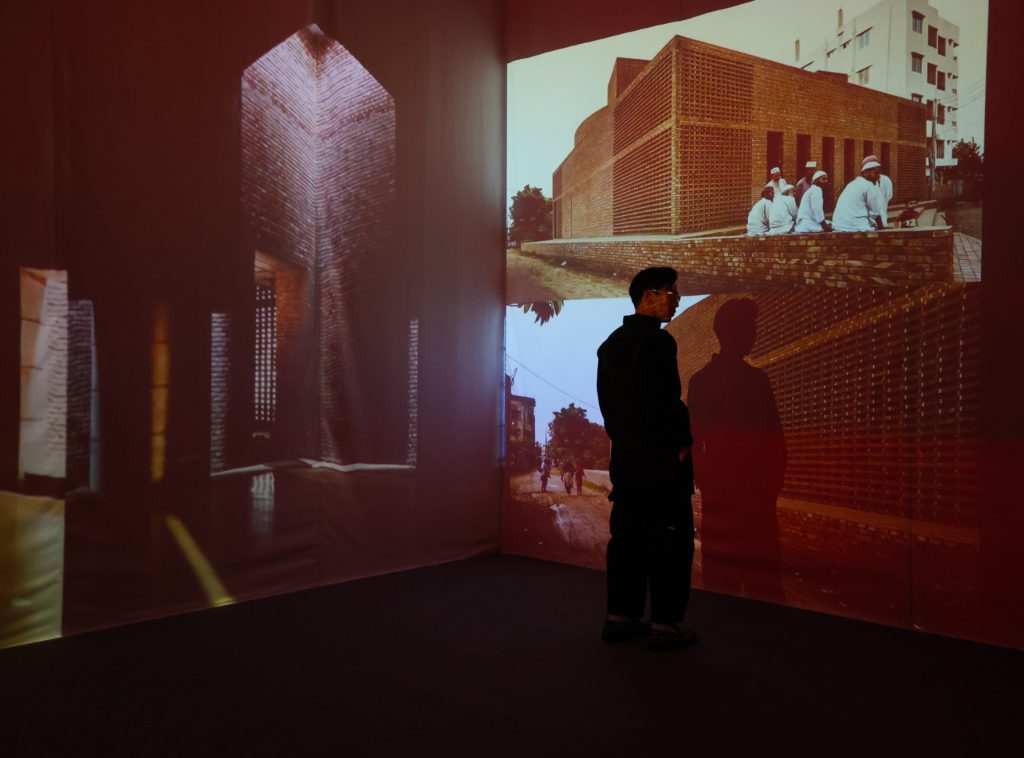
ภาษาร่วมกันของสถาปัตยกรรมเอเชียร่วมสมัย
ตั้งต้นจากธีมของงาน ความหมายโดยตรงของ Collective Language ถูกแปลความออกมาเป็น 3 หัวข้อ ไล่ระดับตั้งแต่ภาษาที่ใช้เสียงในการสื่อสาร ภาษาที่สื่อสารผ่านความเงียบ และภาษาไร้เสียงที่สื่อลึกลงไปในระดับอารมณ์
“คำว่า สถาปัตยกรรมเอเชีย เป็นคำที่สื่อความหลากหลายมาก แล้วพอเป็นหัวเรื่องภาษาร่วม ผมเลยคิดไปถึงสัตว์ ยกตัวอย่างลิง ที่ใช้ภาษาร่างกายในการสื่อสาร หรือแม้แต่อารมณ์ โกรธก็แสดงสีหน้า หรือมีความสุขก็ยิ้ม เหล่านี้ก็เป็นส่วนหนึ่งของภาษา เช่นกันกับนิทรรศการสถาปัตยกรรมเอเชียที่ไม่ต้องการแบ่งแยกภาษาทางสถาปัตยกรรม เราเลยใช้เรื่องภาษาของพื้นที่ที่เกี่ยวกับระดับเสียงที่แตกต่างไปจนถึงความซาบซึ้งทางอารมณ์”
ภาษาพื้นที่ที่ว่าคือการที่ผู้ร่วมชมนิทรรศการสามารถมีส่วนร่วมไปกับทั้ง 12 โปรเจกต์ จากความร่วมมือกับ ARCASIA ซึ่งคัดเลือกมาจากเกณฑ์ของทั้ง 3 หัวข้อ ซึ่งนี่ก็เป็นทั้งความยากและความสนุกในการทำงานกับโปรเจกต์จากแต่ละประเทศที่มีพื้นหลังที่แตกต่างกัน หากแต่มีจุดร่วมที่จิตวิญญาณและความเชื่อในแบบเอเชีย
นาดาเล่าถึงทั้ง 12 โปรเจกต์ในนิทรรศการธีมงาน “ตัวโปรเจกต์ที่เลือกมา เราเลือกมาจากคีย์เวิร์ดของแต่ละงาน ความจริงในหนึ่งงานก็มีหลายภาษาร่วมกันในนั้น แต่ว่าจุดเด่นของแต่ละงานที่เราสัมผัสได้ใช้ภาษาอะไรเป็นหลัก นั่นคือเครื่องมือนั้นเป็นภาษาร่วมที่เกิด ขึ้นในสถาปัตยกรรมร่วมสมัยในปัจจุบัน”
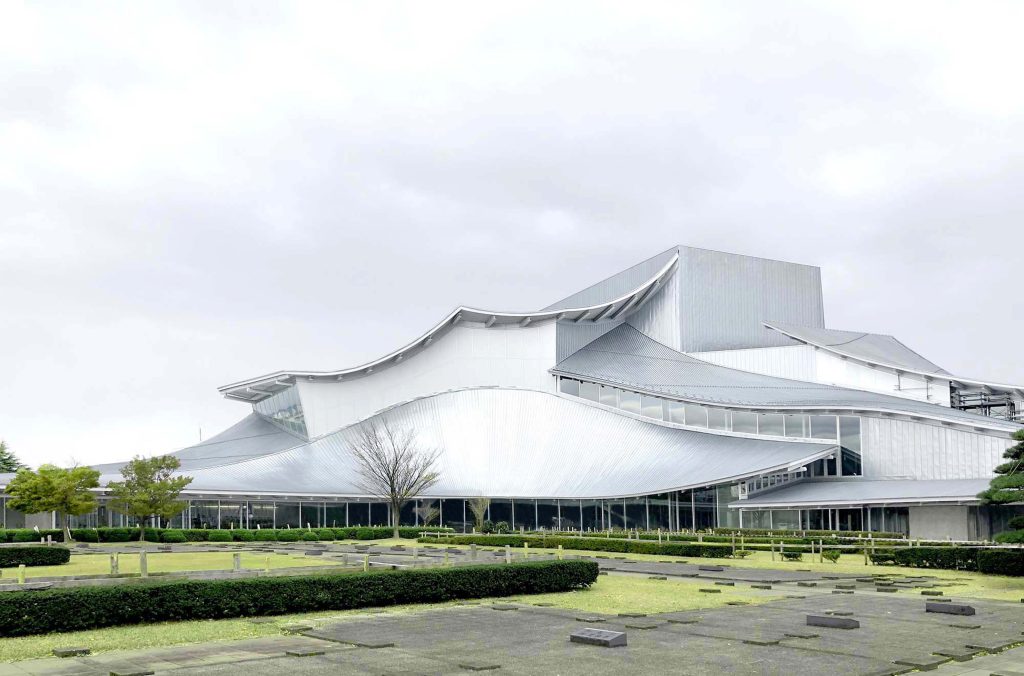
สถาปัตยกรรมเอเชียในฐานะเครื่องมือสื่อสาร
ภาษาทั้งสามนั้น เริ่มต้นภาษาแรก “เสียง/ภาษาแห่งมนุษยชาติ” Sound / Language of Humanity ความรู้สึกแรกสุดจากการสัมผัสสถาปัตยกรรม กลุ่มโปรเจกต์ที่เลือกมาจึงใช้การนำเสนอในแบบ Mapping กับฉากหลังที่เป็นผ้า ด้วยการสร้างมาตราส่วน (Scale) ของรูปทรง ก่อให้เกิด ปริมาตร (Volume) ในพื้นที่ ผ่านการใช้ผิวสัมผัสของวัสดุที่แตกต่างกัน (Contrast) เพื่อกระตุ้นความแตกต่างในการการรับรู้ระหว่างพื้นที่ที่แตกต่าง
“เพราะเราไม่สามารถยกตัวเองไปอยู่ในสถานที่นั้น ๆ ได้ เราเลยใช้องค์ประกอบของภาพ และภาษาทางสถาปัตยกรรมหลักที่คุ้นเคยกันอย่าง ภาพดรออิ้ง เพื่อทำให้คนเข้าใจสเกลมากขึ้น ถึงจะไม่ได้เข้าสเกลแบบ 1:1 แต่เราอยากสร้างความรู้สึกให้ใกล้เคียงกับโปรเจกต์ให้ได้มากที่สุด”
ตัวอย่างผลงาน ศูนย์วัฒนธรรมสึรุโอกะ (Tsuruoka Cultural Hall) (2017) ออกแบบโดย Sejima and Nishizawa and Associates – SANAA นั้นเป็นตัวแทนของความรู้สึกแบบญี่ปุ่นที่โดดเด่นด้วยสัดส่วนทางสถาปัตยกรรมที่เปี่ยมไปด้วยเสน่ห์ ผังการใช้งานที่มีทางเดิน ห้อมล้อมห้องแสดง และหลังคาลอยตัวสร้างความรู้สึกอิสระบางเบา สร้างเสริมให้เกิดการสื่อสารและประสบการณ์ที่แปลกใหม่แก่ผู้เข้าชม ส่วนผลงาน Space K Seoul (2020) โดย Mass Studies มีการตีความลักษณะเมืองที่เป็นเอกลักษณ์และความเป็นมนุษย์ของกรุงโซลผ่านรูปทรงทันสมัย บนพื้นที่ซึ่งมีพลวัตของการออกแบบ ผสานองค์ประกอบทางธรรมชาติ อย่างภูเขาและแม่น้ำฮันเข้าไว้ด้วยกันได้อย่างไร้รอยต่อ หยิบยื่นทางเลือกใหม่ในการดูแลสังคมในสภาพแวดล้อมเมืองที่แออัด ในขณะเดียวกันผลงานที่ smallprojects เป็นผู้ออกแบบ The Machine Room (2019) ได้มีการปรับแก้ขนาดพื้นที่ให้เหมาะกับการอยู่อาศัย อันผสมผสานวัสดุและเส้นทางการเคลื่อนไหว สร้างบรรยากาศใหมที่่เสริมประสบการณ์การอยู่อาศัยได้อีกครั้ง รวมถึงผลงาน Santani Wellness Resort and Spa (2016) ที่ Thisara Thanapathy Associates ออกแบบนั้นมีทางเดินคดเคี้ยวที่ช่วยลดปริมาตรของอาคาร ในขณะเดียวกัน การออกแบบได้รังสรรค์ห้องพักขนาดใหญ่ที่แสดงให้เห็นถึงความแตกต่างและการบูรณาการระหว่างมนุษย์กับสิ่งแวดล้อม ผ่านการสอดประสานระหว่างวัสดุท้องถิ่นและภูมิประเทศแนวเขา
ภาษาที่สอง คือ ความเงียบงัน / ภาษาของแสงเงา Silent / Language of Shading เมื่อเริ่มมีองค์ประกอบอื่นเข้าร่วมจึงเกิดปฏิสัมพันธ์ระหว่างพื้นที่กับสถาปัตยกรรมในแบบที่ลึกซึ้งขึ้นผ่านบริบทที่ส่งผลต่อสถาปัตยกรรม ทั้งสภาพเศรษฐกิจ เมือง ภูมิประเทศ ภูมิอากาศ และวิกฤติโลกร้อน ภาษาสถาปัตยกรรมที่สื่อสารกับเรื่องนี้จึงเป็นองค์ประกอบของหน้ากากอาคาร (Screen) ระบบควบคุมการหมุนเวียนอากาศ (Thermal Comfort) เพื่อโอบอุ้มสิ่งมีชีวิตให้เกิดภาวะอยู่สบายและรับมือกับการเปลี่ยนแปลงของสิ่งแวดล้อมภายนอกผ่านความคิดสร้างสรรค์ในการจัดการพื้นที่ นิทรรศการจึงเล่าผ่านแสงและเงา
หนึ่งในตัวอย่างคือโครงการ Kampung Admiralty (2017) โดย WOHA ที่เสริมสร้างความสัมพันธ์ระหว่างพื้นที่กับสภาพแวดล้อมทางธรรมชาติ และทำหน้าที่เป็นตัวกลางให้ผู้ใช้งานได้สัมผัสกับธรรมชาติในทิวทัศน์ที่ต่างกันไป ในทำนองเดียวกัน อาคารหอพักพยาบาลโรงพยาบาลจุฬาลงกรณ์ (2021) ที่ออกแบบโดย Plan Architect ใช้ประโยชน์จากมุมของโครงสร้างฟาซาด (façade) ในการสร้างระเบียงและพื้นที่เปิดโล่ง รวมไปถึงพื้นที่สีเทา (Gray Space) หรือพื้นที่ที่มีความยืดหยุ่นและสามารถใช้งานได้หลากหลายวัตถุประสงค์ได้อย่างเพียงพอ การออกแบบนี้ช่วยให้ผู้ใช้งานและแพทย์ได้เห็นคุณค่าความสำคัญของการบูรณาการใช้ภาษาเงียบงันให้เข้ากับพื้นที่ระหว่างกระบวนการรักษาที่เข้มข้น สำนักงานเกษตรเมือง หรือ Urban Farming Office (2022) ที่มีสตูดิโอ Vo Trong Nghia Architects เป็นผู้ออกแบบ และห้องสมุดลีลาววตีลาลบาย (Lilavati Lalbhai Library) (2017) ออกแบบโดย RMA Architects เป็นสองโครงการที่นำเอาฝีมือและเทคนิคการก่อสร้างพิเศษมาประยุกต์ใชักับฟาซาด เพื่อทำหน้าที่เป็นสื่อกลางของการเปลี่ยนผ่านระหว่างสภาพแวดล้อมภายนอกและภายใน นอกจากนี้บริเวณเอเทรียม (Atrium) หรือโถงกลางภายในของทั้งสองอาคารยังช่วยส่งเสริมความต่อเนื่องของพื้นที่แต่ละส่วน ทำให้ผู้เยี่ยมชมสามารถสัมผัสถึงความสัมพันธ์ที่เปลี่ยนแปลงอยู่ตลอดเวลาระหว่างสถาปัตยกรรมและธรรมชาติ
ภาษาสุดท้าย คือ “การซึมซาบ / ภาษาของพิธีกรรม” Perceive / Language of Ritual เป็นอีกเลเยอร์หนึ่งของการสัมผัสที่ลึกซึ้ง คือการเข้าถึงจิตวิญญาณ นิทรรศการเลือกสื่อสารผ่านการใช้แสงธรรมชาติ เพื่อปลุกประสาทสัมผัสให้เรามองเห็นความแตกต่างว่า ไม่ใช่งานสถาปัตยกรรมทุกชิ้นที่สามารถทำให้คนเกิดความรู้สึกแบบนั้นได้ การออกแบบคือเครื่องมือที่ทำให้ไปถึงความลึกซึ้งตรงนั้น ภาษานี้ต้องการสะท้อนวัฒนธรรม ความเชื่อ และศรัทธาของผู้คน ด้วยการหยิบยกมูลค่าทางวัฒนธรรม (Legacy) ของแต่ละถิ่นที่ ทั้งด้านเทคนิค วัสดุ รูปทรง เมื่อความเปลี่ยนแปลงของเวลาและธรรมชาติ (Time and Nature) ที่แตกต่างกันไปตลอดวันมาพบกับพื้นที่ในภาวะจำกัดและบีบคั้นความรู้สึกผ่านการใช้ขนาด (Overscale) ยิ่งสร้างเอฟเฟกต์และผลกระทบต่อความรู้สึกของผู้ใช้พื้นที่จนหลอมรวมเข้าไปในหัวใจ
ผลงานสี่ โครงการจากประเทศจีน อินโดนีเซีย ฟิลิปปินส์ และบังกลาเทศ แสดงให้เห็นถึงวิธีที่สถาปัตยกรรมสามารถประกอบขึ้นจากแนวคิดต่าง ๆ เช่น มรดก ความกลมกลืน และการบีบอัด หนึ่งในตัวอย่างคือพิพิธภัณฑ์เตาเผาราชวงศ์โบราณจิ่งเต๋อเจิ้น (Jingdezhen Imperial Kiln Museum) (2020) ออกแบบโดย Studio Zhu Pei ที่ใช้แนวทางการออกแบบเชิงนวัตกรรมเพื่อจุดประกายชีวิตให้กับที่ตั้งโครงการที่มีพื้นหลังทางวัฒนธรรมอันเป็นเอกลักษณ์ขึ้นมาใหม่ ผ่านรูปทรงสถาปัตยกรรมและวัสดุที่ก่อร่้างสร้างตัวเป็นเรื่องราวด้วยองค์ประกอบของแสงและพื้นที่ ในทำนองเดียวกัน มัสยิดอัส-โซบูร์ & เซสซัตอากุง (Masjid As-Sobur & Sessat Agung) (2017) ที่สตูดิโอ andramatin ออกแบบ ได้ก้าวข้ามข้อจำกัดทางศาสนาที่มีความเป็นทางการ และเสนอประสบการณ์ทางประสาทสัมผัสอันลึกซึ้งแก่ผู้ใช้งานผ่านสัดส่วนของพื้นที่และการเลือกใช้วัสดุ ในขณะที่โครงการอย่าง โบสถ์ 100 กำแพง (The 100 Walls Church) (2013) โดย Carlos Arnaiz Architects และมัสยิดบายต์อุรรูฟ (Bait Ur Rouf Mosque) (2012) โดย Marina Tabassum Architects นั้นมีการใช้รูปทรงพื้นฐานเฉพาะตัวและโครงสร้างน้ำหนักเบาเพื่อสร้างบรรยากาศทางจิต วิญญาณที่โดดเด่น โดยบูรณาการอาคารทางศาสนาให้เป็นอันหนึ่งอันเดียวกับชุมชนและมอบประสบการณ์ที่ไม่ธรรมดาแก่กิจวัตรประจำวันของผู้คน
เจอร์รี่ยกตัวอย่างความสัมพันธ์ระหว่างทั้งสามหมวดหมู่ผ่านการจัดการพื้นที่ “ผมยกตัวอย่างงานของ SANAA ที่ผู้คนรับรู้ได้ว่าคืองานสถาปัตยกรรมแบบญี่ปุ่น แต่หลายคนก็อาจยังสงสัยว่า ทำไมวัฒนธรรมญี่ปุ่นจึงมีความสำคัญกับประเทศต่าง ๆ ในเอเชียด้วย นิทรรศการครั้งนี้ไม่ได้พูดถึงแค่นี่เป็นสถาปัตยกรรมญี่ปุ่นหรือไม่ แต่เราพูดผ่านพื้นที่ซึ่งเชิญชวนทุกคนเข้ามาร่วมทำความรู้จักและเข้าใจโปรเจกต์ผ่านวิธีการบอกเล่า บางงานถึงแม้จะเป็นโปรเจกต์เล็ก ๆ แต่การแบ่งเป็น 3 หมวดหมู่แบบนี้ก็อาจจะทำให้เห็นภาพของสถาปัตยกรรมเอเชียที่ชัดเจนขึ้น”
“นิทรรศการครั้งนี้มีความท้าทายอย่างมาก แต่สำหรับผมแล้ว สิ่งสำคัญที่สุดคือ อย่างน้อยงานครั้งนี้ต้องสามารถส่งต่อข้อความบางอย่างให้กับผู้ชมได้ และจะยิ่งดีถ้าผู้คนจะมีบทสนทนาเกิดขึ้น มีหัวข้อในการพูดคุย นี่จะยิ่งทำให้ความรู้สึกจากการชมงานยิ่งแข็งแรงขึ้น”
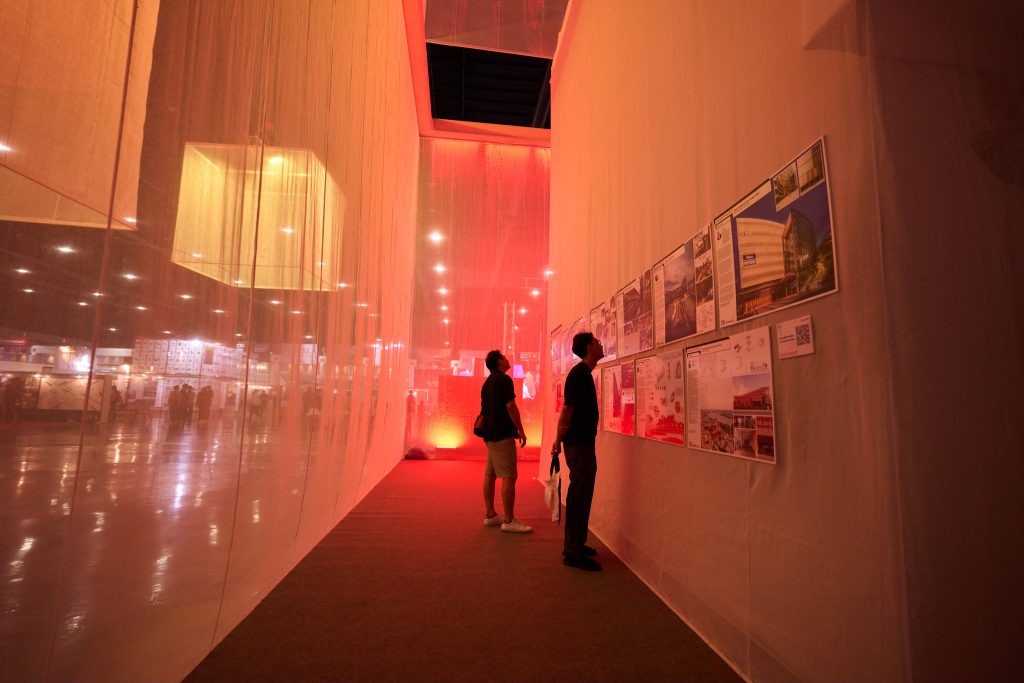
ยกระดับสู่งานนิทรรศการระดับนานาชาติ
นอกจากภาษาทางสถาปัตยกรรมที่จำเป็นจะต้องสร้างการสื่อสารสองทางระหว่างผู้ส่งสารอย่างทีมภัณฑารักษ์ และผู้รับสารซึ่งเป็นผู้เข้าชมงาน ให้เข้ามาสัมผัสสถาปัตย์ได้อย่างเข้าใจแล้ว สำหรับคนเบื้องหลังอย่างคุณนาดา ภาษาในการสื่อสารและประสานงานกับสถาปนิกต่างวัฒนธรรมจากทั่วทุกมุมโลกเป็นอีกความท้าทายหนึ่งในการสร้างสรรค์นิทรรศการครั้งนี้
“เพราะเราต้องประสานงานรวบรวมทั้ง 12 สถาปนิก จากสมาคมพันธมิตร 21 ประเทศใน ARCASIA มาไว้ด้วยกัน อันนี้คือการสื่อสารด้วยภาษาแบบของแท้ เราได้เห็นวัฒนธรรมของแต่ละประเทศที่ไม่เหมือนกัน ทั้งจากการติดต่อประสานงาน การเจรจา ซึ่งแต่ละบริษัทสถาปนิกเป็นเบอร์ ใหญ่ทั้งนั้น เราก็ต้องใช้วิธีการพูดคุยที่แตกต่างกัน นี่จึงเป็นความรู้สึกที่ว่า นอกจากจะเป็นภัณฑารักษ์ที่ต้องสื่อสารกับผู้ชมแล้ว เราก็ต้องสื่อสารเพื่อให้ได้ในสิ่งที่เราต้องการด้วย”
หากแต่ความท้าทายในครั้งนี้กลับเป็นความสนุกในการทำงานภัณฑารักษ์ของนาดา เพราะนอกจากการได้ร่วมงานกับสถาปนิกในระดับนานาชาติแล้ว การจัดนิทรรศการหลักในงานสถาปนิก’67 ทำให้เธอได้พบกับเคมีการทำงานที่สนุกเข้ากันของทีม และยังเป็นเวทีที่ทำให้ได้ร่วมทำงานกับแต่ละส่วนงานนิทรรศการทั้งหมดที่กระจายตัวอยู่ในส่วนหลักของอาษา
“อย่างวันที่มี Session พูดคุยกัน ก็ทำให้เราได้เห็นว่าเขาคิดแบบนี้นี่เอง เลยเป็นความสนุกที่ว่าการได้ทำงานร่วมกับทีม และการได้สัมผัสกับสถาปนิกทีมอื่น ๆ เป็ นแบบไหน และเป็นประสบการณ์ที่ดีในการเรียนรู้จากทางทีมสมาคมฯ จนออกมาเป็นนิทรรศการหลักที่ภูมิใจ”
นิทรรศการเป็นงานสำหรับคนรุ่นถัดไป
ความสำค ัญของนิทรรศการนี้สำหรับเจอร์รี่ คือเขาอยากให้เป็นนิทรรศการที่สนุกที่ทุกคนทุกเพศทุกวัยเข้าถึงได้ เพราะสำหรับเขาแล้ว หน้าที่ของการจัดนิทรรศการคือ การกระตุ้นจิต ใจของผู้ชม
“ส่วนตัวผมสนใจในภูมิภาคเอเชียของเรา ผมสนใจในเรื่องวัฒนธรรม เมือง ประวัติศาสตร์ ไปจนถึงปรัชญาสถาปัตยกรรม เพราะฉะนั้นผมคิดว่าการมีประสบการณ์ในพื้นที่จัดแสดงผลงานสถาปัตยกรรมก็มีความสำคัญไม่น้อยไปกว่าผลงานสถาปัตยกรรมเอง เพราะผมอยากสื่อสารให้เข้าถึงสาธารณชน ความท้าทายในครั้งนี้จึงเป็นทั้งเรื่องของพื้นที่จัดงานที่ใหญ่กว่าพื้นที่สถาปัตยกรรมทั่วไป ผู้เข้าร่วมงานหลายหมื่นคนต่อวัน ผมเลยอยากทำให้นิทรรศการครั้งนี้สนุก เพลิดเพลิน เพราะเป้าหมายที่อยากให้ผู้คนเข้าใจสถาปัตยกรรมเอเชีย ผมสังเกตเห็นว่า แม้แต่เด็กก็เข้ามาร่วมสนุกกับงานนี้ ผมจึงหวังว่างานนี้จะมอบแรงบันดาลใจและความคิดสร้างสรรค์ที่มีความหมายให้กับเขาต่อไปในอนาคต”
“คำว่า เอเชีย สำหรับผมมันกว้างใหญ่มาก และในงานนี้ทุกคนก็มาด้วยความมุ่งมั่นในวิชาชีพสถาปนิก และจากเป้าหมายที่ต้องการยกระดับงานสถาปนิกให้ไปสู่ระดับนานาชาติ ผมจึงคิดว่าผมโชคดีมากที่ได้รับเชิญมาร่วมเป็นภัณฑารักษ์หลักในนิทรรศการหลักของงาน”
นอกจากพื้นที่นิทรรศการในงานแล้ว เจอร์รี่ชี้ให้เห็นภาพที่กว้างกว่าคือพื้นที่สื่อ ผู้ทำหน้าที่สื่อสารเรื่องราวจากบนพื้นที่จริงไปสู่พื้นที่เสมือนออนไลน์สำหรับผู้สนใจทั่วโลก เหมือนกับเป็นการเปิดประตูคำว่า ‘สถาปัตยกรรมเอเชีย’ ออกไปสู่สากล
“ผมคิดว่าส่วนหนึ่งที่ทำให้นิทรรศการครั้งนี้ประสบความสำเร็จเป็นอย่างมากก็เพราะสื่อจากต่างประเทศ ทั้งญี่ปุ่น อินเดีย หรือแม้แต่ Archdaily ที่เข้ามาสัมผัสพื้นที่และสร้างสรรค์บทความเพื่อนำเสนอออกไปในเวทีโลก ทำให้ผู้คนสนใจว่าสถาปัตยกรรมเอเชียเป็นอย่างไร แล้วจะเติบโตต่อไปอย่างไร และพอเป็นบทความที่ไม่เป็นเชิงการค้า ทำให้สื่อสามารถแสดงทรรศนะของตัวเองหรือวิพากษ์วิจารณ์งานได้อย่างเต็มที่ ซึ่งนี่ก็เป็นบทพิสูจน์ว่า สถาปัตยกรรมเอเชียอยู่ในสายตาของชาวโลก”
งานเลี้ยงย่อมมีวันเลิกรา นิทรรศการย่อมมีวันปิดตัว แต่สำหรับเจอร์รี่แล้ว ‘นิทรรศการเป็นงานสำหรับคนรุ่นถัดไป’
“เพียงแค่คนที่เข้ามาดูได้รับอะไรกลับไปก็นับว่าเป็นการจบงานที่ดีแล้ว ผมเชื่อว่าหลายคนอาจจะไม่ได้ดูครบทุกงาน หรือดูวิดีโอไม่จบด้วยซ้ำ ดังนั้น ทุกครั้้งที่คนเข้ามาก็อาจจะสังเกตเห็นวิดีโอคนละคลิป โปสเตอร์คนละชิ้น แสงสว่่างคนละแบบ ซึ่่งก็มอบอารมณ์ที่แตกต่าง ความรู้สึกที่แตกต่าง หรือแม้แต่คนละวัน วันแรกคุณมาด้วยความสดใหม่จากนิทรรศการที่ชมเป็นครั้งแรก วันที่สองกลับมาอาจจะเหนื่อยคนเยอะมาก วันที่สามกลับมาตั้งใจดูงานที่อยากดูจริง ๆ เหล่านี้สะท้อนกลับไปถึงหัวข้อของธีมงาน Collective Language ได้ชัดเจนมากผ่านทางการสื่อสารระหว่างนิทรรศการกับผู้ชมในพื้นที่”
Language ignites the spark of creativity
This simple yet profound statement transcends the mere exchange of spoken or written words, suggesting that language encompasses gestures, emotions, desires, and instincts. Over time, these forms of communication have evolved from primitive grunts and signals to the sophisticated articulation of thoughts through speech. Beyond this, language has extended into the realm of objects, such as art and architecture, demonstrating that mutual understanding is indeed possible.
“COLLECTIVE LANGUAGE: Sensing Architecture” is the centerpiece of Architects Expo’24, designed to immerse viewers in a boundless design experience. These works communicate beyond mere descriptions; they foster shared understanding and perceptions.
The exhibition unfolds through a main display and various activities, emphasizing ‘sensibility’ as a form of ‘architectural’ communication. This approach aims to inspire and promote positive future collaborations within the architectural community.
Collective Language – Asian Contemporary Architecture employs language as a means to connect all elements of the world. Tens of thousands, or even millions, of years ago, language manifested in various forms among different creatures, including auditory whistle language, visual body language, tactile perception language, olfactory smell language, and more. However, the origin and development of language still spark different discussions. In 1809, French biologist Jean-Baptiste Lamarck published “Zoological Philosophy,” proposing that as the environment changes, species adapt and develop their own organs. This adaptation leads to the growth of commonly used organs and the gradual degeneration of unused ones. The acquired changes in one generation are then passed on to the next. This discussion not only introduces new perspectives to linguists but also demonstrates how different creatures have used diverse methods to communicate through language over millions of years.
Jenchieh Hung, the exhibition chairman and principal curator of The Association of Siamese Architects under Royal Patronage delves into the diversity and distinctions that language brings to hearing, vision, touch, and smell, structured into three languages: “Sound / Language of Humanity,” “Silent / Language of Shading,” and “Perceive / Language of Ritual.” Through these chapters, nearly 50 architectural firms from 15 Asian countries showcase the contemporary architecture of Asia.
“Language is about communicating so the receiver understands the information or needs we convey. However, language facilitates bidirectional communication between the diverse architectural works of architects from various countries and us, the viewers,” says Nada Inthaphunt, the exhibition’s Executive Curator. She interprets this architectural language as “a gateway to understanding architectural dialogue.”
The challenge set by this architectural language from the Chairmen of the ASA Architect’s Expo, elevated by the exhibition’s international scale, has led to collaborations with the Architects Regional Council Asia (ARCASIA). This partnership invites participation from 21 countries, each contributing to this shared language through diverse cultural and intellectual architectural works.
“Beginning with the phrase ‘Collective Language,’ we decipher with the Expo Chairman; Kulthida Songkittipakdee that architectural language can be categorized into three layers or levels of experience when interacting with architecture. Starting with the most superficial layer of sound, we progress to a deeper level of silence and finally reach the spiritual essence, which we illustrate through architectural projects to clarify the concept more vividly.”

Sparked by a burning question about the essence of ‘Asian’ architecture
The dynamic exhibition is a curatorial endeavor of Jenchieh Hung, the principal curator of Collective Language – Asian Contemporary Architecture. Jenchieh has long contemplated the distinctions and commonalities within Thai, Chinese, and Japanese architecture, which are commonly defined by their national identities. Yet, he wondered, is the term ‘Asian architecture’ as widely recognized?
Jenchieh Hung, also co-founder and principal architect at HAS design and research, has been deeply influenced by his experiences in China, Japan, and Thailand. This background has fueled his ongoing engagement with the notion of an ‘Asian’ architectural identity, a fascination that culminated in creating the COLLECTIVE LANGUAGE exhibition. Jenchieh reflects, “I am very interested in the identity of being Asian. This question reemerged when I began working on this exhibition, compelling me to pursue further exploration.”
The roots of this quest trace back to Jenchieh’s teaching days in China, where his students’ curiosity about Thai architecture sparked his interest. Conversely, questions about Chinese and Japanese architecture in Thailand—enhanced by his several years at Kengo Kuma and Associates—deepened his engagement with architectural practices across Asia. “These questions have continually fueled my interest in Asia and its architectural vernacular,” Jenchieh notes.
The ‘Asian Contemporary Architecture Exhibition’ is a beacon for this exploration. “Previously, you couldn’t find anything about this topic online. Now, after Architect Expo’24, journalists from around the globe are covering this exhibition. This has been a tremendous source of satisfaction,” Jenchieh expresses, noting the widespread impact of the event.
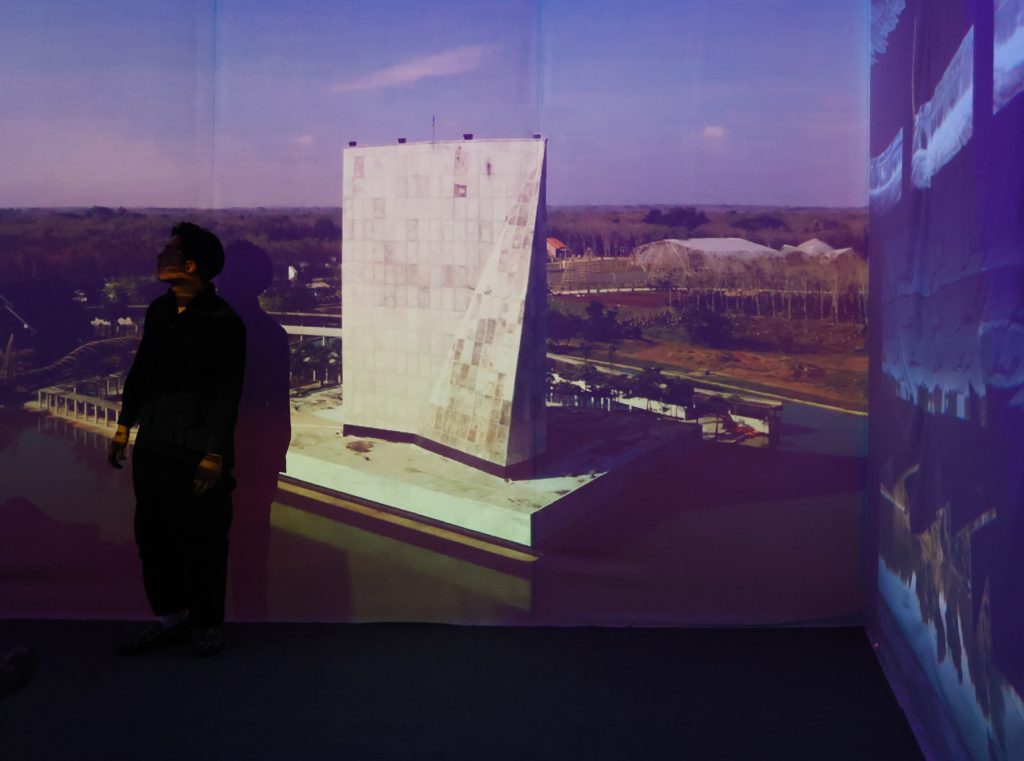
A Collective Language of Contemporary Asian Architecture
The theme of the Contemporary Asian Architecture exhibition is inspired by the intriguing concept of Collective Language, which is divided into three categories: the audible communication of language, the conveyance of messages through silence, and the profound depths of non-verbal emotional expression.
“The term ‘Asian architecture’ encompasses immense diversity,” the principal curator Jenchieh Hung notes. “Addressing shared language reminded me of animals like monkeys, who communicate through body language, their facial expressions telegraphing anger or joy—these are forms of language. Similarly, this exhibition doesn’t aim to compartmentalize architectural languages but rather to embrace the varied languages of space, from vocal nuances to deep emotional resonances.”
The exhibition’s spatial language invites attendees to immerse themselves in all 12 projects, carefully curated in partnership with ARCASIA to reflect these thematic pillars. This process is both challenging and exhilarating, as it involves integrating works from diverse cultural backgrounds that, despite their differences, echo the unified spirit and shared philosophies characteristic of Asian traditions.
In discussing the curated projects within the exhibition’s thematic scope, Nada Inthaphunt explains, “The selection was based on the unique keywords of each project.” While each project may encompass various aspects of a collective language, what stood out was the predominant use of a specific and discernible communicative form. This is the collective language that today’s contemporary architecture vividly brings to life.”
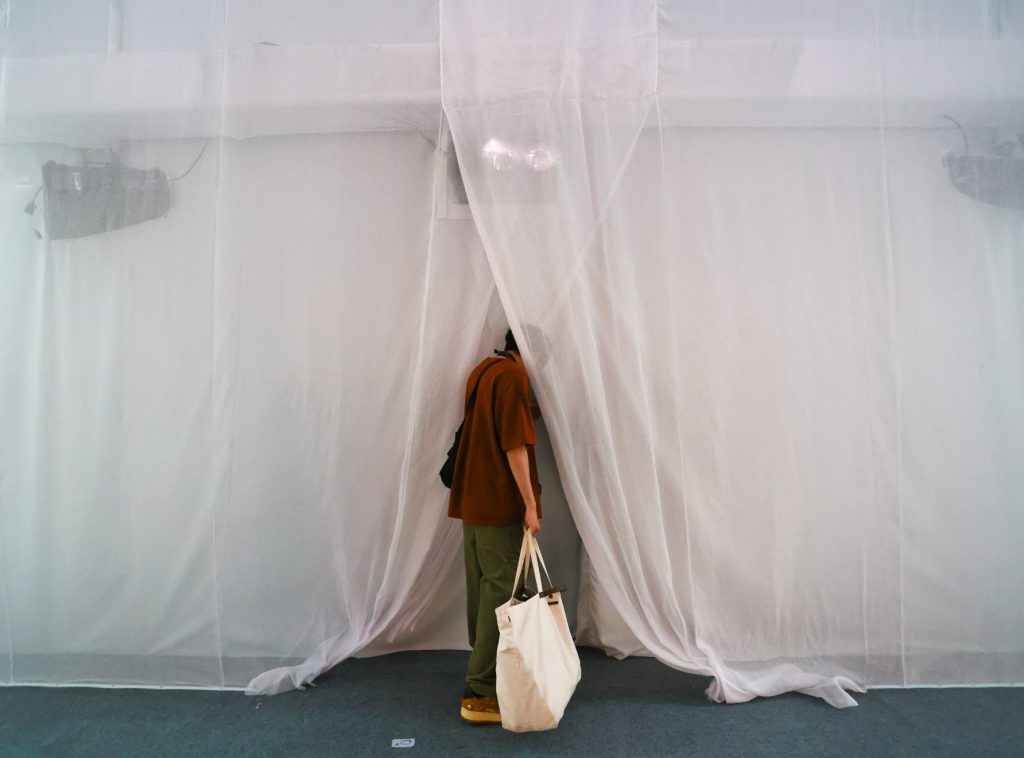
Asian Architecture as a Communication Tool
The concept of “Sound / Language of Humanity” serves as the starting point for understanding the communicative power of architecture, as it’s the primal interaction one experiences with built environments. In the curated projects, this idea is visualized through a mapping approach set against a fabric backdrop. These installations create a sense of volume within the space by manipulating the scale of forms and using contrasting material textures to highlight perceptual differences betweendistinct areas.
“Since we couldn’t physically relocate these works to the expo’s setting, we utilized graphic elements and familiar architectural representations, such as drawings, to deepen our understanding of scale. Although we cannot achieve a direct 1:1 scale, our objective is to offer spectators the best possible sense of these projects’ scale,” the principal curator Jenchieh Hung elucidates.
Sejima and Nishizawa and Associates – SANAA’s Tsuruoka Cultural Hall (2017) epitomizes the unique Japanese sense of space with its charming architectural proportions. The functional layout, featuring a corridor enveloping the performance hall and a floating roof, fosters a sense of freedom and lightness, encouraging unique communication and experiences among visitors. Mass Studies’ Space K Seoul (2020) interprets Seoul’s distinctive humanistic urban characteristics through streamlined shapes and dynamic spaces. The design seamlessly integrates natural elements like mountains and the Han River, embodying an alternative approach to social care in densely populated urban environments. The Machine Room (2019) by smallprojects is tailored to the specific scale of living spaces. Through a combination of materials and movement lines, it creates a new ambiance that enhances the living experience. Santani Wellness Resort and Spa (2016) by Thisara Thanapathy Associates features a meandering circulation that reduces the building’s volume. By incorporating local materials and blending with the mountain topography, the design establishes a rich-scale building complex that demonstrates the contrast and integration between people and their environment.
The second language is Silent / Language of Shading. “As additional elements come into play, a deeper interaction between space and architecture emerges,” shaped by contexts like economic conditions, urban settings, geography, climate, and the global warming crisis. The architectural language communicating these themes includes building façades (screens) and thermal comfort systems designed to ensure livable conditions and adapt to external environmental changes through creative space management. The exhibition tells this story through light and shadow.
For example, WOHA’s Kampung Admiralty (2017) strengthens the relationship between space and the natural environment, acting as a mediator for participants to experience natural elements in different settings. Similarly, Plan Architect’s Nurse Dormitory at Chulalongkorn Memorial Hospital (2021) utilizes varying façade angles to create balconies and open spaces, providing ample gray space. This design allows patients and doctors to appreciate the integration of silent language and space during intense treatment processes. Vo Trong Nghia Architects’ Urban Farming Office (2022) and RMA Architects’ Lilavati Lalbhai Library (2017) incorporate special craftsmanship and construction techniques on their façades to mediate the transition between external and internal environments. Additionally, the internal atrium in both projects enhances the flow of each space, enabling visitors to experience the evolving relationship between architecture and nature.
The last language, Perceive / Language of Ritual, unfolds as a compelling layer of architectural dialogue—touching on the profound, reaching into the spirit. This segment of the exhibition leverages natural light to awaken the senses, subtly guiding observers to recognize that not all architecture possesses the capacity to stir such depth of emotion. Here, design transcends its traditional role, acting instead as a conduit to such experiences. This narrative seeks to mirror the diverse cultures, beliefs, and faiths through the architectural legacy lens—highlighting each locale’s unique techniques, materials, and forms. It captures how varied elements of time and nature blend with confined spaces, pressing emotions into expansive dimensions of “overscale.” This interaction crafts sensory effects and influences the emotions of those engaging with the spaces, embedding complex feelings within their core.
Four projects from China, Indonesia, the Philippines, and Bangladesh exemplify how architecture can embody concepts like legacy, harmony, and compression. For instance, the Jingdezhen Imperial Kiln Museum (2020) by Studio Zhu Pei employs innovative design to rekindle the site’s unique cultural background through architectural forms and spatial materials, crafting a narrative with light and space. Similarly, andramatin’s Masjid As-Sobur & Sessat Agung (2017) transcends formal religious constraints, offering visitors profound sensory experiences through spatial proportions and material choices. The 100 Walls Church (2013) by Carlos Arnaiz Architects – CAZA and the Bait Ur Rouf Mosque (2012) by Marina Tabassum Architects both use precise spatial forms and lightweight structures to evoke a distinct spiritual ambiance, integrating the religious buildings into their community environments and providing unique, non-daily life experiences.
Through thoughtful spatial management, Jenchieh Hung emphasizes the interconnectedness between three categories. “Take the work of SANAA, for example, which is recognized as Japanese architecture, yet it prompts the intriguing question of why Japanese culture resonates significantly with other Asian nations as well. This exhibition goes beyond merely questioning the categorization of Japanese architecture; it actively encourages viewers to immerse themselves and comprehend the projects through a narrative lens. The organization of even smaller projects ensures a clearer representation of Asian architecture.
“This exhibition poses considerable challenges, but for me, the pivotal aspect is its ability to communicate a meaningful message to the audience. It would be even more impactful if it could incite conversations and discussions. This would profoundly enrich the viewing experience of the exhibition.”
Toward an International Exhibition
Creating an architectural language that facilitates a two-way dialogue between the curatorial team and visitors is crucial for deepening their understanding of architecture. Yet, for someone like Nada working behind the scenes, the real challenge lies in communicating and coordinating with architects from diverse cultural backgrounds worldwide to curate this exhibition.
“We had to coordinate and bring together 12 architects from ARCASIA’s 21 member countries. This was a true exercise in linguistic and cultural communication. Through our interactions and negotiations, we experienced the unique cultures of each country. Each architectural firm we worked with was a major player in its respective country, necessitating different communication strategies. Our role extended beyond simply curating an exhibition for the audience; we also needed to communicate effectively to achieve our goals.”
For Nada, however, this challenge became an enjoyable aspect of her curatorial work. Collaborating with international architects for the main exhibition at Architect Expo’24 provided her with engaging work dynamics and fostered a strong sense of teamwork. The event became a platform for her to work closely with various exhibition teams within the main section of ASA.
“During the discussion sessions, it was fascinating to understand the unique perspectives of each architect. The enjoyment came from working with the team and interacting with other architectural teams, which provided a great learning experience for the association. This culminated in a main exhibition that we are all proud of.”

The exhibition is for the next generation.
For Jenchieh, the importance of this exhibition lies in making it enjoyable and accessible to everyone, regardless of age or gender. He believes an exhibition’s role is to stimulate its audience’s minds.
“Personally, I’m interested in the culture, cities, history, and architectural philosophy of our Asian region. Therefore, I believe experiencing the exhibition space is as important as experiencing the architectural works. I want to communicate these ideas to the public. The challenge is that the exhibition space is much larger than typical architectural spaces, with tens of thousands of visitors daily. I aim to make this exhibition fun and to help people understand Asian architecture. I’ve noticed that even children are engaging with the exhibition, and I hope it will inspire them and spark meaningful creativity in their future.”
“The term ‘Asia’ is inclusive for me. Everyone participating in this event is dedicated to the profession of architecture and has the goal of elevating it to an international level. I am deeply grateful for the invitation to spearhead the main exhibition as the principal curator.”
Beyond the exhibition space, Jenchieh Hung emphasizes the broader scope, which includes the media. The media’s role is to convey the stories from the physical space to the virtual online space for interested audiences worldwide, effectively opening the doors of ‘Asian architecture’ to the global stage.
One key factor contributing to the success of this exhibition is the involvement of international media from countries like Japan and India and platforms like Archdaily. They experience the space and create articles to present it on the world stage, sparking interest in Asian architecture and how it will grow. Since these articles are not commercially driven, the media can fully express their opinions and critique the work. This proves that Asian architecture is indeed in the global spotlight. At the same time, I also honor the ASA Architect Expo by the four chairmen – Chutayaves Sinthuphan, Kulthida Songkittipakdee, Prompt Udomdech, Rattapong Angkasith, letting the world see this wonderful message.”

Parties may wind down, and exhibitions may close their doors, but for Jenchieh Hung, ‘exhibitions are an affair for the next generation.’
“Merely having attendees take something away with them signifies a successful conclusion. Likely, many visitors won’t see every piece or finish every video. Consequently, each visit can be markedly different: one visitor might encounter a distinct video clip, another a different poster, and another unique lighting—each element fostering a unique mood and a different emotional response, even varying by the day. On the first day, you might arrive fresh, experiencing the exhibition for the first time; by the second day, you could return, overwhelmed by the crowds; and the third day, come back with a determined focus to engage deeply with a piece that truly captures your interest. Each of these experiences speaks directly to the theme of ‘Collective Language,’ illustrating the dynamic interplay between the exhibition and its audience within the space.”
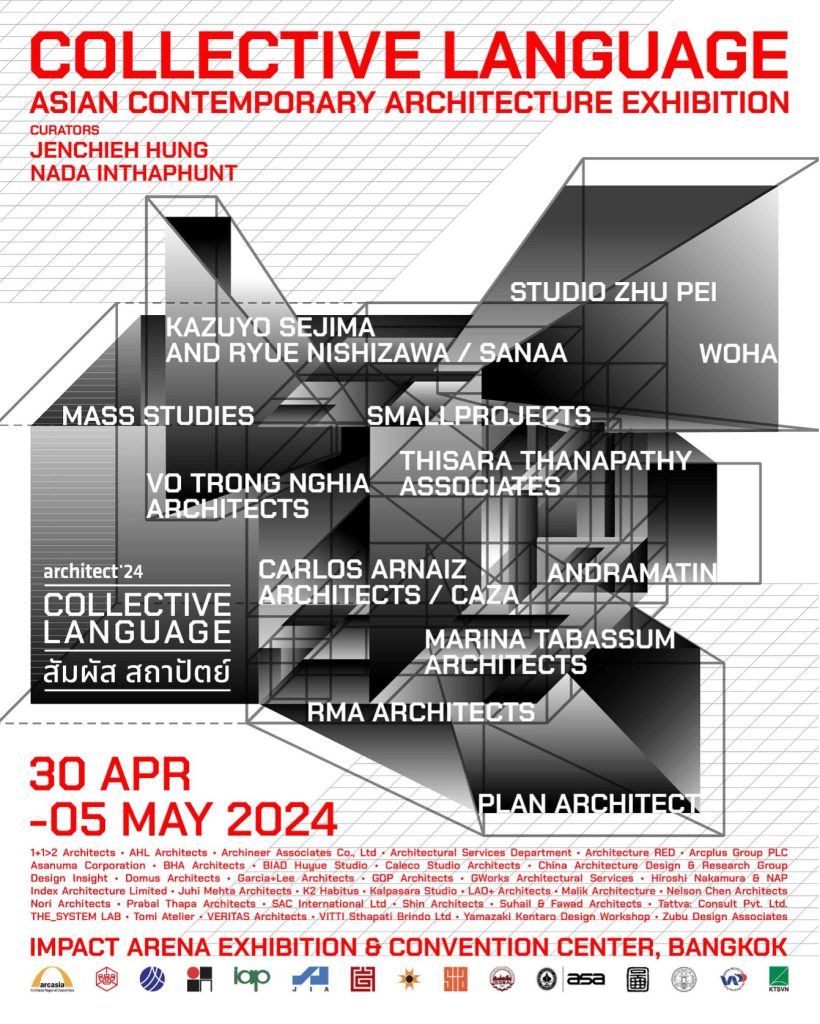
อ่านบทความคอลัมน์อื่นๆ หรือดาวน์โหลดเล่มวารสารฉบับออนไลน์ 18 Collective Language คลิกได้ที่นี่
อ่านบทความคอลัมน์อื่นๆ หรือดาวน์โหลดเล่มวารสารฉบับออนไลน์ Collective Language: EPILOGUE คลิกได้ที่นี่



